We’re launching a crowdfunding campaign around our Novena open hardware computing platform. Originally, this started as a hobby project to build a computer just for me and xobs – something that we would use every day, easy to extend and to mod, our very own Swiss Army knife. I’ve posted here a couple of times about our experience building it, and it got a lot of interest. So by popular demand, we’ve prepared a crowdfunding offering and you can finally be a backer.
Background
Novena is a 1.2GHz, Freescale quad-core ARM architecture computer closely coupled with a Xilinx FPGA. It’s designed for users who want to modify and extend their hardware: all the documentation for the PCBs are open and free to download, and it comes with a variety of features that facilitate rapid prototyping.
We are offering four variations, and at the conclusion of the Crowd Supply campaign on May 18, all the prices listed below will go up by 10%:
- “Just the board” ($500): For crafty people who want to build their case and define their own style, we’ll deliver to you the main PCBA, stuffed with 4GiB of RAM, 4GiB microSD card, and an Ath9k-based PCIe wifi card. Boots to a Debian desktop over HDMI.
- “All-in-One Desktop” ($1195): Plug in your favorite keyboard and mouse, and you’re ready to go; perfect for labs and workbenches. You get the circuit board above, inside a hacker-friendly case with a Full HD (1920×1080) IPS LCD.
- “Laptop” ($1995): For hackers on the go, we’ll send you the same case and board as above, but with battery controller board, 240 GiB SSD, and a user-installed battery. As everyone has their own keyboard preference, no keyboard is included.
- “Heirloom Laptop” ($5000): A show stopper of beauty; a sure conversation piece. This will be the same board, battery, and SSD as above, but in a gorgeous, hand-crafted wood and aluminum case made by Kurt Mottweiler in Portland, Oregon. As it’s a clamshell design, it’s also the only offering that comes with a predetermined keyboard.
All configurations will come with Debian (GNU/Linux) pre-installed, but of course you can build and install whatever distro you prefer!
Novena Gen-2 Case Design
Followers of this blog may have seen a post featuring a prototype case design we put together last December. These were hand-built cases made from aluminum and leather and meant to validate the laptop use case. The design was rough and crafted by my clumsy hands – dubbed “gloriously fuggly [sic]” – yet the public response was overwhelmingly positive. It gave us confidence to proceed with a 2nd generation case design that we are now unveiling today.
The first thing you’ll notice about the design is that the screen opens “the wrong way”. This feature allows the computer to be usable as a wall-hanging unit when the screen is closed. It also solves a major problem I had with the original clamshell prototype – it was a real pain to access the hardware for hacking, as it’s blocked by the keyboard mounting plate.
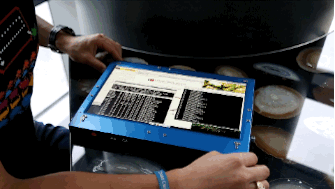
Now, with the slide of a latch, the screen automatically pops open thanks to an internal gas spring. This isn’t just an open laptop — it’s a self-opening laptop! The internals are intentionally naked in this mode for easy access; it also makes it clear that this is not a computer for casual home use. Another side benefit of this design is there’s no fan noise – when the screen is up, the motherboard is exposed to open air and a passive heatsink is all you need to keep the CPU cool.
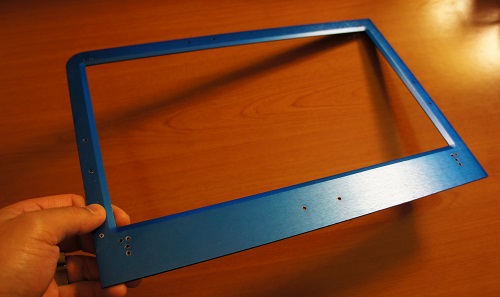
Another feature of this design is the LCD bezel is made out of a single, simple aluminum sheet. This allows users with access to a minimal machine shop to modify or craft their own bezels – no custom tooling required. Hopefully this makes adding knobs and connectors, or changing the LCD relatively easy. In order to encourage people to experiment, we will ship desktop and laptop devices with not one, but two LCD bezels, so you don’t have to worry about having an unusable machine if you mess up one of the bezels!
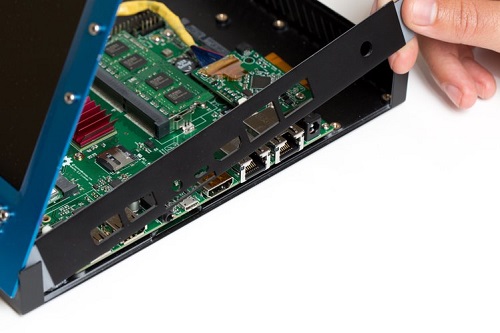
The panel covering the “port farm” on the right hand side of the case is designed to be replaceable. A single screw holds it in place, so if you design your own motherboard or if you want to upgrade in the future, you’re not locked into today’s port layout. We take advantage of this feature between the desktop and the laptop versions, as the DC power jack is in a different location for the two configurations.
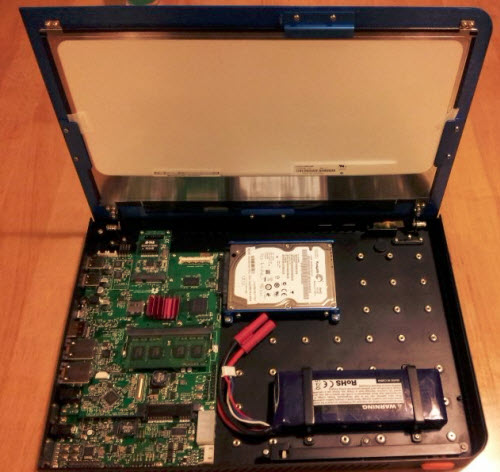
Finally, the inside of the case features a “Peek Array”. It’s an array of M2.5 mounting holes (yes, they are metric) populating the extra unused space inside the case, on the right hand side in the photo above. It’s named after Nadya Peek, a graduate student at MIT’s Center for Bits and Atoms. Nadya is a consummate maker, and is a driving force behind the CBA’s Fab Lab initiative. When I designed this array of mounting bosses, I imagined someone like Nadya making their own circuit boards or whatever they want, and mounting it inside the case using the Peek Array.
The first thing I used the Peek Array for is the speaker box. I desire loud but good quality sound out of my laptop, so I 3D printed a speakerbox that uses 36mm mini-monitor drivers, and mounted it inside using the Peek Array. I would be totally stoked if a user with real audio design experience was to come up with and share a proper tuned-port design that I could install in my laptop. However, other users with weight, space or power concerns can just as easily design and install a more modest speaker.
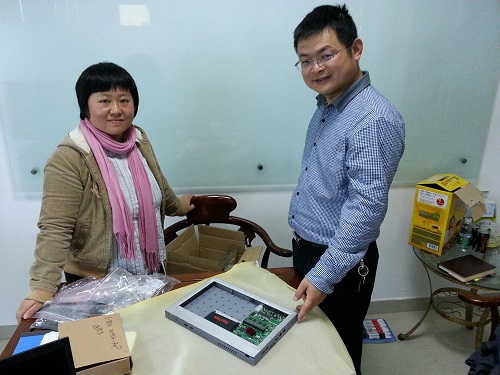
I started the Gen-2 case design in early February, after xobs and I finally decided it was time to launch a crowdfunding campaign. With a bit of elbow grease and the help of a hard working team of engineers and project managers at my contract manufacturing partner, AQS (that’s Celia and Chemmy pictured above, doing an initial PCBA fitting two weeks ago), I was able to bring a working prototype to San Jose and use it to give my keynote at EELive today.
The Heirloom Design (Limited Quantities)
One of the great things about open hardware is it’s easier to set up design collaborations – you can sling designs and prototypes around without need for NDAs or cumbersome legal agreements. As part of this crowdfunding campaign, I wanted to offer a really outstanding, no-holds barred laptop case – something you would be proud to have for years, and perhaps even pass on to your children as an heirloom. So, we enlisted the help of Kurt Mottweiler to build an “heirloom laptop”. Kurt is a designer-craftsman situated in Portland, Oregon and drawing on his background in luthiery, builds bespoke cameras of outstanding quality from materials such as wood and aluminum. We’re proud to have this offering as part of our campaign.
For the prototype case, Kurt is featuring rift-sawn white oak and bead-blasted-and-anodized 6061 aluminum. He developed a composite consisting of outer layers of paper backed wood veneer over a high-density cork core with intervening layers of 5.5 ounce fiberglass cloth, all bonded with a high modulus epoxy resin. This composite is then gracefully formed into semi-monocoque curves, giving a final wavy shape that is both light, stiff, and considers the need for air cooling.
The overall architecture of Kurt’s case mimics the industry-standard clamshell notebook design, but with a twist. The keyboard used within the case is wireless, and can be easily removed to reveal the hardware within. This laptop is an outstanding blend of tasteful design, craftsmanship, and open hardware. And, to wit, since these are truly hand-crafted units, no two units will be exactly alike – each unit will have its own grain and a character that reflects Kurt’s judgment for that particular piece of wood.
How You can Help
For the crowdfunding campaign to succeed, xobs and I need a couple hundred open source enthusiasts to back the desktop or standard laptop offering.
And that underlies the biggest challenge for this campaign – how do we offer something so custom and so complex at a price that is comparable to a consumer version, in low volumes? Our minimum funding goal of $250,000 is a tiny fraction of what’s typically required to recover the million-plus dollar investment behind the development and manufacture of a conventional laptop.
We meet this challenge with a combination of unique design, know-how, and strong relationships with our supply chain. The design is optimized to reduce the amount of expensive tooling required, while still preserving our primary goal of being easy to hack and modify. We’ve spent the last year and a half poring over three revisions of the PCBA, so we have high confidence that this complex design will be functional and producible. We’re not looking to recover that R&D cost in the campaign – that’s a sunk cost, as anyone is free to download the source and benefit from our thoroughly vetted design today. We also optimized certain tricky components, such as the LCD and the internal display port adapter, for reliable sourcing at low volumes. Finally, I spent the last couple of months traveling the world, lining up a supply chain that we feel confident can deliver this design, even in low volume, at a price comparable to other premium laptop products.
To be clear, this is not a machine for the faint of heart. It’s an open source project, which means part of the joy – and frustration – of the device is that it is continuously improving. This will be perhaps the only laptop that ships with a screwdriver; you’ll be required to install the battery yourself, screw on the LCD bezel of your choice, and you’ll get the speakers as a kit, so you don’t have to use our speaker box design – if you have access to a 3D printer, you can make and fine tune your own speaker box.
If you’re as excited about having a hackable, open laptop as we are, please back our crowdfunding campaign at Crowd Supply, and follow @novenakosagi for real-time updates.
Tags: hacking, laptop, novena, open hardware

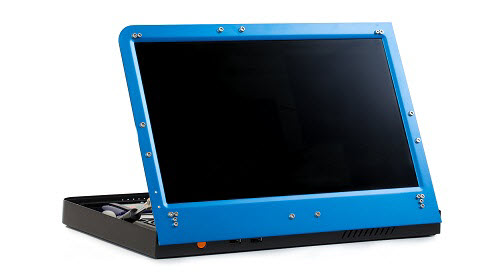
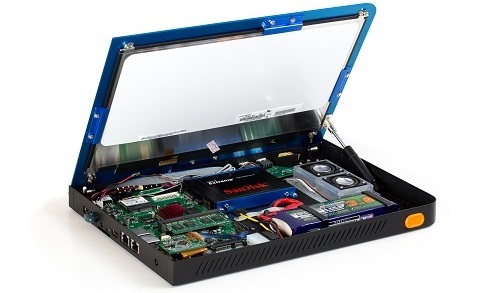
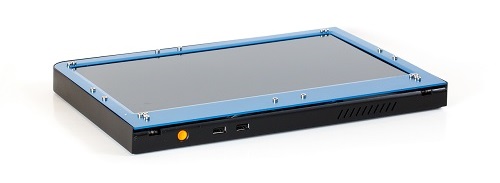
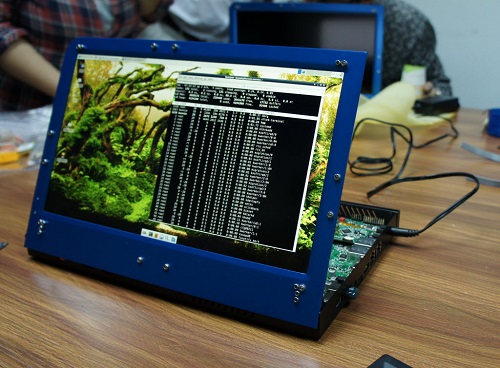
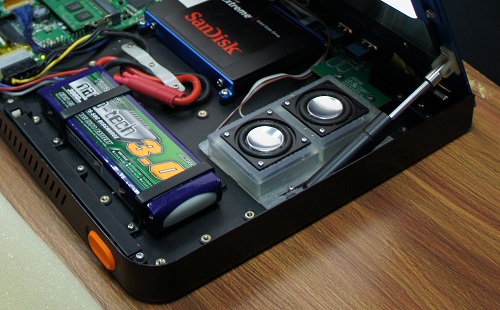
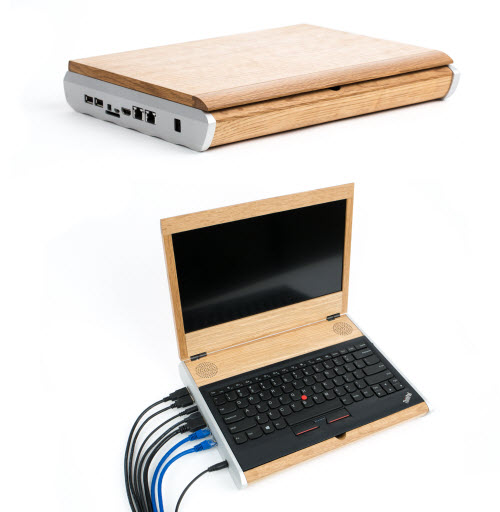
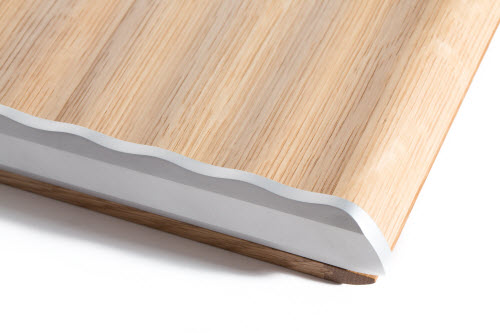
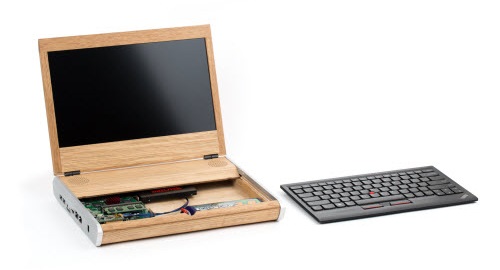
Congrats guys, it looks really awesome.
Is the battery board going to be available on its own too?
I was wondering this as well, the features you list sound great but I have most of the other stuff laying about for the laptop version, an extra $800 for a battery board is kind of prohibitive.
me, too.
Miss the board+battery board option, too
Board+battery board would get a lot of backers from the Maker community. Novena seems great for large embedded projects with portable power.
Can you bring some protos to SZ for MF/hackercamp would love hear you do a talk about it if Ian can squeeze you in.
I’ll be in SZ and Ian asked me to give a talk about it — if he can squeeze me in, I’ll have the laptop prototype with me!
Congratulations and I hope to to see you and the laptop in Singapore this summer :)
Great work, looking forward to hear more :)
Bloody awesome. Will buy one if I can convince my wife…
Not that I’m complaining (just curious), but why the Spartan6 324-package? Is it just BOM cost? The reason I ask: The SLX45 is top of the line for that package. If you’d used the 484 package, then you’d be pin-compatible with all the beefier Spartan6’s too (all the way up to the beefier SLX150’s).
It was more of a concern of being able to go down, not up — the larger packages lock you into a minimum price floor that’s pricey even by these standards…the first prototypes used an LX9, for example.
I love this a lot. I’m probably going to back it. One question I have — how hard would it be for me to add a keyboard? A laptop without a keyboard is more like a somewhat-more-portable desktop. With the case opening the way it does, it seems to me that adding a keyboard would actually be decently challenging, yes?
I might get the all-in-one-desktop version instead, mostly because of this, but not sure.
The general idea I had for people who wanted to add the keyboard was that it could be an LCD bezel mod. It’s a weekend project for people with access to a Techshop or other machine shop to add screws to the aluminum bezel and add 3D printed brackets that can hold the keyboard of your choice.
Hmm, interesting idea. So the keyboard could sort of fold onto the screen or something. I’ll think more about that option.
For the FPGA — I’m guessing there aren’t FLOSS synthesis tools out there, so that has to be done on another device. How hard is it to move the synthesis output over to the Novena and program the FPGA?
I really love this machine but sadly don’t think that I could afford to get the heirlom design and really need to have a clamshell type machine to use.
Is there any chance of a slightly cheaper design that fits between the $1995 and the $5000.
I’m almost disappointed that you’re not selling a version with the semi-transparent leather case =)
ugly, thick and expensive. if that was your goal – congratulations…
Congrats for missing the point.
Wow. Great design! Apparently some don’t understand prototyping. However, I do agree for the $ a “standard” keyboard should be issued.
Very nice. I noticed the design files were done with Altium, a fairly high-end CAD system running on Windows.
Do you ever envision a day when the Novena could run the software to design itself?
I’d love for that day to come…but in the meantime, baby steps toward that conclusion.
Wow, finally a laptop with a user accessible FPGA and GPIO !
Going in the way of J. Peterson, I guess we will not be able to synthesize a program on the Novena… That’s a bit sad, but this will be my next laptop :)
Great job on this, Bunnie! It’s sooo far out of my price range that I’ll only get to see it up close if one of my friends happens to buy one… but… still awesome!! :)
Wish you the best of luck getting off the ground, I’m definitely rooting for you!
Congrats on getting this out! I’m sure you’re getting lots of requests already and prioritizing is important, but just one idea: sell the mainboard, screen, screen board, and battery board, but no case (except maybe the port panel). I’ll be looking to make my own case (looking for laptop use with standard opening clamshell) and would hate to dump a bunch of aluminium.
If you don’t want to clutter up the crowdsupply page, having this available after the crowdfunding period, with the price premium, would be good as well.
I’ll probably be going for the desktop version as I’m a sucker for open source hardware.
Anyone spot the text on the screen behind bunnie? Y3Jvd2RzdXBwbHkuY29tL25vdmVuYS1wdXp6bGU=
No idea what it could mean.
#echo -n Y3Jvd2RzdXBwbHkuY29tL25vdmVuYS1wdXp6bGU= | base64 -d
crowdsupply.com/novena-puzzle
I’ve got a new background image. Thanks to everyone for building and maintaining open hardware, you are awesome.
Why not use a wooden keyboard to make it a complete wooden art?
http://oreedesign.com/products/oree-board
I think it would be much more fun!
Great to see this coming about!
Since I can’t really come up with worthwile personal uses yet (maybe when freedombox grows stronger), will it be better to buy a board or just back you guys up with say 100 or 200 dollars?
Like a lot about this, but honestly, when I buy a wood version of a 2.000$ laptop for 5.000$ and it doesn’t say WORLDWIDE FREE SHIPPING, then you drive me off.
That’s a mistake. Let me talk to crowd supply to fix that.
Sorry about that!
We’ve fixed the issue, and refunded shipping to existing international backers on the laptop versions. Sorry and thanks for pointing that out.
i have ssd’s and rc battery packs a gogo laying around,
a 240gb SSD + that RC battery pack, that’s about 300usd, the price difference betwene “desktop and “laptop” (wich is desktop + charger board + ssd + battery if i’m correct) is 800 usd.
So is it really 500usd for the battery charger board? that’s the same price as the mainboard.. :)
I am bitterly disappointed that the product you describe as a “Laptop” isn’t actually a laptop. I had been looking forward to a free hardware laptop.
I don’t understand why you changed from the prototype laptop design to some bizarre thing with the screen round the wrong way that you can’t use on your lap. This change of design is not cool. Using the word “laptop” to describe the product is also not cool.
Woe is me. Woe is all of us who were interested in a laptop.
I think it is like a tablet that converts to a desktop. I love the design and hope to get one.
> I think it is like a tablet that converts to a desktop.
That doesn’t contradict anything I’ve said.
I’m disappointed by this too – I was really looking forward to a laptop with the OEM thinkpad keyboard and high-DPI screen that Bunnie mentioned in previous posts. I’ll still buy/sponsor the board or the desktop because Novena looks like a useful instrument, but it is quite a letdown.
I’d actually like to do something about that.
Some of my ideas:
-reuse old/defective notebooks (perferably thinkpads), either with the nice 1400×1050 resolution, if screen is intact. Or as “case only”, which would require some research in sizes of suitable screens. Like the “up-cycling” of that idea
-design a steampunk version of a notebook
-a carbon verison
So who is in?
Addition: What about to copy bunnies leather and acryl scren holder hinge design we saw at the 30c3? (and improve it a bit?)
One thing that is uttermost important to me: Will the laptop be “Respects your freedom” certified by the FSF?
We checked on that possibility and until we have completed reverse engineering the GPU and VPU drivers and are offering open alternatives, we won’t qualify. The system is quite usable without the GPU/VPU, but leaving those units turned off and unloaded isn’t good enough to achieve RYF certification.
I dig it. The port plate and mounting grid makes the case brilliant for any project that needs a monitor and an enclosure.
Please consider offering the case (with display) separately. Its modularity is perfect for Novena, but also brilliant for other projects.
Thanks!
Question: What is the front surface of the LCD? Durability? I am expecting we will need a sleeve of cover of some sort.
Overall its a cool design. I was REALLY hoping it would follow the bunnie “book” design we saw in early protos. If there was a board+bat board option avail, i would probably byild my own that way. I am very much a on-lap laptop user. Very often table-less
awesome work. I gotta figure out how to make a crystal clear laptop case now so I can look like zero cool.
I do like how the “laptop” version kinda looks like radical edward’s computer.
I read on HAD that it has a Thinkpad keyboard and thought to myself, yes, leave it to Bunny to be the voice of reason in a world of insanity. So I surf on over here only to find out that it has the GD chicklet keyboard! Grrrrrrrrrrrrrrrr…
Just make your own. That’s what I did.
Buy a ThinkPad keyboard, solder wires to, say an ATMega 32, flash USB keyboard software on it, map keys, plug in keyboard, enjoy. The TrackPoint speaks plain PS/2, shouldn’t be hard to handle that.
[…] “bunnie” Huang has announced an effort to crowdfund an open laptop. They are ARM-based “hacker laptops” (and […]
Can I just by the eDP to LCD adapter board?
*LVDS
Not currently, but the source is available for download. It’s a pretty easy one to fab, all the parts are hand-solderable.
does that apply to the battery board, too?
So the “laptop” mentions it has an SSD – are you guys building it yourself or is it a mass manufactured one? :)
It’s mass-manufactured. I’m currently looking at the Intel 530.
SSDs are hard to get right, I wouldn’t trust myself to build an SSD.
Which Spartan-6 will be included on the board? There’s an almost 5x difference in LUTs between the smallest and largest CSG324 parts.
LX45
With the current laptop design how hard would it be to convert into a clamshell format.
Assuming that the bezel is chamged and a bracket is put in place to hold a keyboard.
Related to this what is the cooling like when the unit is closed?
$2,000 for a 1.2Ghz Arm powered laptop that comes with no operating system and has to be assembled by the customer. Obviously I must be missing the point but I just don’t get it.
Yes, you are missing the point entirely
And you missed that it comes with OS ,-)
Congratulations bunnie and xobs !
While I might not afford to buy it at the moment I highly appreciate your approach to this project, fully open and with attention to detail, committed to metric system and so on. I hope it will be wildly successful and will lead to bigger things. Who knows, one day other manufacturers will be forced (by us, the buyers) to copy your business model and become friendlier to open hardware and free software themselves.
I was wondering if it’s possible to use the LG LP129QE HiDPI screen you showed earlier on the desktop/laptop model? Maybe it’s just me, but isn’t the eDP adapter board different than the one on your previous blog post?
If I were to back one of those two options, I would like to have a lot of pixels :)
Yes, we revised the eDP adapter board. The previous design was hard to source and the documentation of the chipset was very closed. This new one is better on that account.
As noted in a previous blog post, the LG LP129QE display requires overclocking the i.MX6 display output port. As a result, on some units the image quality can be sub-par. Also, since hardware acceleration drivers haven’t been written, the user experience can be a little sluggish at times. The FHD panel we’re using in this design is a better match overall with the specs of the i.MX6 CPU.
And that’s the beauty of open source hardware/software, I can always try to get different kinds of panels working :)
Btw, I cannot for the life of me find the IT6251 chip anywere (digikey, RS, Mouser, aliexpress, Ebay, etc.). Am I that horrible at searching?
[…] información | Novena en CrowdSupply | BunnieStudios En Xataka | Project Novena: ¿Se puede construir un portátil totalmente Open […]
I noticed the wifi card has two attached antennae. Does it also do bluetooth?
If not can you recommend a card that does both?
Fabulous job and a really important idea!
Wyolum (opensource hardware wienies) are likely to get 3-4 units.
I’m hoping we’ll think of something else cool to put inside.
It has two antennae for signal diversity — if one antenna is in a null, the other has a chance to receive signal still. Both are for wifi.
There are other cards that integrate wifi + BT but they aren’t as “libre” as the one we picked for this campaign. We haven’t really investigated them as openness was a key requirement.
However, we do use BT with the system through a logitech BT dongle that we plug into the USB ports. It seems pretty much any standard BT dongle works out of the box.
Hello Bunnie & Team !
My name is Zean Moore and I love your project !
I work in the media and product development industries and would like to reach out to you in hopes of aiding your projects. I have worked in a variety of fields and teammates find that my skills are found to be highly supportive and my passions ever driving.
I have a number of ideas that could benefit your pursuits, or that could spark healthy business relations. This isn’t a pitch, mearly a call to action on my own account.
Please, feel free to contact me via email.
At the very least, I am looking forward to backing your efforts !
Cheers !
Zean Moore
What type of connector is the “High-speed I/O expansion header”? Are there breakout cables available for it?
Apologies if it is listed on http://bunniefoo.com/novena/pvt1_release/novena_pvt1.PDF – my inexperienced eyes can’t find it. I’m interested in seeing what is routed to it.
You say in the post
> if you design your own motherboard
It would be useful for such people to be able to buy the case only. Plenty of folks with EE design skills have no particular facility with MechE.
Hi Eric,
what about to buy the Laptop option together?
For me the Mainboard, battery board are “must haves”, and the Display+eDP are “nice to have”.
Do you think that might work? Does that fit your must/nice have wishes?
[…] Crowdfunding the Novena Open Laptop […]
I was quite looking forward to this after the previous posts. Now it’s here I’m terribly disappointed.
This is still being presented as a laptop, yet only at the $5000 level does one get something that is actually in a laptop form factor. I’d love to see a video showing someone comfortably using the $1995 “laptop” on their lap, with a keyboard also on their lap.
At the lowest end of the scale, $500 gets you Yet Another ARM Development Board. Great, something else to compete for space with all the other rubber-footed boards on my desk. I think not.
Good luck with the campaign. Hopefully there are enough people with deep pockets and who fit into your particular use cases to make it a success.
Will you be selling your charge board edp, and lvds cables after the campaign?
Hi, excuse me for the bad English… I like the geek laptops. But this price is too high for this low-end processor, sorry! Now I have/use az x86_64 Lenovo T530 laptop with Core i7 proc, 16 GB RAM. And it was <1500$.
I understand, that a beginner project should have bigger price, and I am ready to give more money for a very geek laptop. But not for a low laptop…
My claims/requirements:
Intel Core i7 proc, minimum 16 GB RAM with possibility to expand it to 64 GB. 1 TB HDD, minimum 250 GB SSD as second "hdd", 3 USB 3.0 port, 2 USB 2.0 port, ethernet connector. The cover made by aluminium, titanium, &cromium, NOT with wood!
With builtin english keyboard, AND with lot of extra programmable buttons/keys to UTF-8 sequences, because I use very lot of difference extra characters from the Unicode table. (hebrew, hungarian, hindi, german, esperanto, etc). Of course, I hate to see the ugly Windows button, therefore I want in place of it a nice penguin!
Yes, you're well, I am NOT an hardware-hacker. I not like to assembly it, but I would like to have a very geek laptop, but highly customizable and expandable/extendable in the future, and FULLY Linux-compatible! The 3D is no significant for me, dont worry. It is enough for me a low-end videocard, to a 2D graphic, because I not play with computergames. But in all other things it should be a „monster power” laptop.
And, I would like if it would be compatible with the docker station of my Intel T530 laptop-docker, or, if you would planned an own docker station to them.
Bunnie, in your video available the link to your future plannings… It is good to you?
Congratulations, you …
The … begins on …
Check back to get the … how you could …
(The … are in aboive, because I not want debunk/denounce your future plans).
Hi folks, I urge you to consider a DIY option which would basically be the laptop option but with the electronics only. This would be an ideal kit for those looking to retrofit an older laptop chassis with new internals or people making custom mods.
The display and MB are the most difficult(or impossible) pieces of hardware for individuals to source, so please ad atleast this combination to the choices of bundles to back up and I’m sure you are seeing more interested people showing up.
costs for international shipping for the $500 version would be nice too.
Or will deliver yourself to 31c3, for those who are there?
YmFzZTY0X2RlY29kZQ==, really :)
How come the price of the desktop is so much more than just the board? Case + LCD panel + eDP board + mounting kits/etc seem like they shouldn’t be $200 more than the cost of the board?
(My problem is I can’t decide if I really want to get the desktop version, or if I’d have more fun getting two of the raw boards…)
Any thoughts about how to protect these devices from the NSA on import? ( see: http://www.theguardian.com/books/2014/may/12/glenn-greenwald-nsa-tampers-us-internet-routers-snowden )
[…] [Bunnie] is announcing the launch of the Novena Open Laptop. When we first heard he was developing an open source laptop as a hobby project, we hoped […]
Appreciate some other exceptional posting donate. The spot different may well anybody get that kind of information in that great manner of publishing? I get a powerpoint presentation in the near future, that i’m within the look for like info.